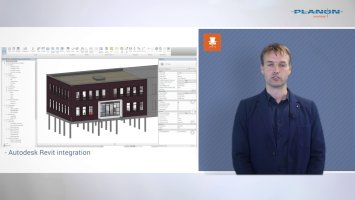Building Information Modelling (BIM) is increasingly getting the attention of organisations involved in architecture, engineering and construction (AEC), as well as the owners and operators of buildings (facility managers and real estate managers). In this context ‘building' refers to the building data and process, where BIM is a digital model representing physical, technical and functional characteristics of that building.
There are many uses of Building Information Modelling. BIM is a shared data and knowledge platform for all stakeholders involved and provides a basis for decision-making during the entire lifecycle of a building: design, build, maintain, operate and demolish. BIM benefits different stakeholders at different phases of the lifecycle of a building. They can add, query or edit information in the Building Information Model to support their own function and share this information with other stakeholders.
The application of Building Information Modelling is much more than a 3D CAD drawing representing a floor plan or construction details. BIM includes data of interest to many stakeholders during the full lifecycle of the building such as buyers, owners, occupants, facility and real estate managers, safety inspectors, lawyers, and emergency planners. BIM can also support in building surrounding processes like geographical analyses, urban planning and landscaping.
As building maintenance and operations reflect over 90% of total lifecycle costs, Real Estate and Facility Managers have an increasing interest in using Building Information Modelling (BIM). The model keeps essential information on multiple aspects of a building or asset like spatial information, technical documentation, cost information, vendor data, or operating guidelines.
BIM bridges the traditional information loss associated with handling a project from the AEC team to the building owner and operator. By closing this gap between construction and building operation, all available data helps in saving time, effort, and money in running and maintaining the building during its entire life cycle, including its demolishment.
Planon Connect for BIM
In our Space & Workplace Management solution, a new standard BIM integration is available: Planon Connect for BIM is a solution that provides a bidirectional data exchange of spaces and assets between BIM and the Planon Universe platform. The solution primarily focuses on Autodesk Revit, a market leading BIM technology for architects, engineers, and contractors.
Planon Connect for Bim
The many dimensions of Building Information modelling
Uses of Building Information Modelling are varied. BIM can include many dimensions of data to support processes for different stakeholders. A Building Information Model includes 3D coordinates and vector information that represent the geometry of the building and its components, including eventual geospatial data. 4D BIM adds time as a new dimension to the model. This enables planners and constructors to visualise activities subsequently on a timeline, for example in the time frame the construction needs to be created. 5D BIM includes the linking of cost related data to any component of the Building Information Model, allowing designers, contractors, or investors to visualise the progress of construction activities and its related costs over time. 6D BIM is the “As-Built” model including information such as product data, maintenance manuals, photos, warranty data, manufacturer information and contacts. 6D BIM plays a key role in using BIM successfully during the operation phases of buildings and therefore needs special attention from Facility Managers and Real Estate professionals.
BIM in architecture, engineering, and construction
Using Building Information Modelling as a central information and collaboration platform during design, engineering, and construction of any building brings many benefits. It reduces the number of data sources drastically, resulting in less failure, increased speed of delivery, improved productivity and collaboration, higher quality and reduced costs. As multiple technical disciplines like construction detailing and electro technical and mechanical engineering are unified in one BIM platform, the impact of any change in any discipline is immediately visually available for all other disciplines. This increases interdisciplinary collaboration and drastically reduces failures or clashes during the design, engineering and construction phase.
BIM in operations
Building owners, Facility and Real Estate Managers and Service Providers can reap the benefits of Building Information Modelling as it stores vital information for many processes during the operation phases of a building’s lifecycle. Information like spatial data, asset details, documentations and graphical information can support processes during the operation of buildings like space management, asset management, maintenance planning, energy management and reconstruction projects during the lifecycle.
To ensure that the BIM gets enriched with relevant and useable information for building maintenance and operations, it’s key to analyse this information need during the initiation and start of the AEC phase. As mentioned, processes are supported by IWMS or CAFM solutions, a bidirectional BIM connector allows data exchange between BIM and IWMS. Because the geometrical data remains maintained and changed in the BIM, data exchange with IWMS occurs on a frequent basis.
BIM Software
Software can be used to build, maintain and visualise all aspects of BIM. This includes interactive capabilities, such as clicking on a floor level of a building to see who the tenants are, rendering a view of the urban landscape from a particular window of a building, or determining which vendor has installed the heating system. Elements such as time (4D) and cost (5D) enhance the capability for lifecycle management. Some leading products for BIM are Revit (Autodesk), ArchiCAD (Graphisoft), Bentley and Tekla.
To avoid Building Information Modelling problems and re-use BIM successfully in operations, the previously mentioned integration with IWMS and CAFM solutions is a key requirement. BIM software vendors and the AEC industry are taking several initiatives for standardisation exchange formats, like the Constructions Operations Building Information Exchange (COBie) in the United States.
Read more: Planon – the first company to unveil a new BIM standard for data exchange
Legislation
In various countries, it has become mandatory to use BIM during the design and construction phase, including an efficient information transfer to the building operation phases. This is often combined with new financing and operating contracts like Design Build Finance Maintain Operate (DBFMO) or Public Private Partnerships (PPP).
Many Facility Managers and Real Estate Managers will be faced with these Building Information Models in future years and need to consider how to benefit and how to exploit them successfully. In the United Kingdom, the government started the Government Soft Landing (GSL) programme, that aims to reduce operating costs and improve carbon performance by involving users and operators during the design process. ‘Soft Landing’ also refers to a smooth transition from the construction phase to maintenance and operations. For any governmental project in the UK, the use of BIM is mandatory since 2016.
More about Building Information Modelling





